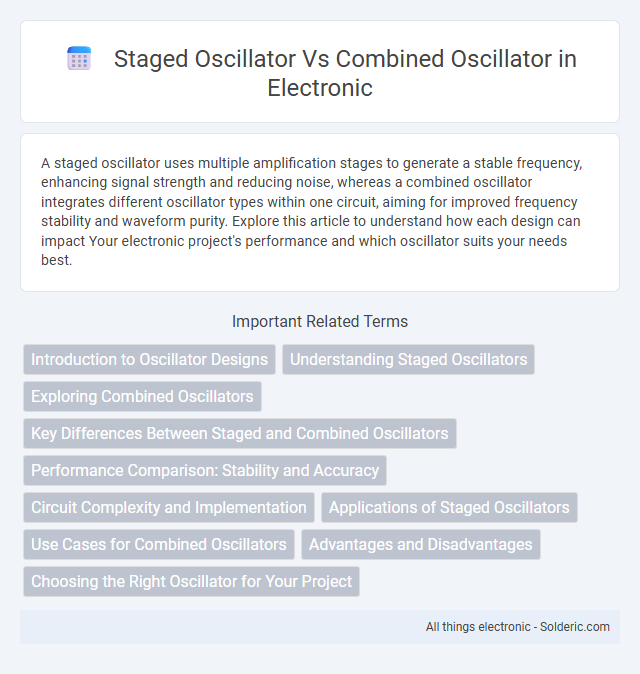A staged oscillator uses multiple amplification stages to generate a stable frequency, enhancing signal strength and reducing noise, whereas a combined oscillator integrates different oscillator types within one circuit, aiming for improved frequency stability and waveform purity. Explore this article to understand how each design can impact Your electronic project's performance and which oscillator suits your needs best.
Comparison Table
| Feature | Staged Oscillator | Combined Oscillator |
|---|---|---|
| Definition | Oscillator with multiple cascaded stages generating output signal | Oscillator combining different oscillation methods in one circuit |
| Frequency Stability | Moderate, depends on stage design | Higher, due to hybrid configuration |
| Complexity | Lower, simpler cascaded design | Higher, integrates various oscillator types |
| Output Signal | Single waveform from cascaded stages | Mixed waveform from combined sources |
| Applications | Basic signal generation, simple timing circuits | High precision timing, advanced signal processing |
Introduction to Oscillator Designs
Staged oscillators use sequentially connected amplifier stages, enhancing gain and frequency stability through cascaded feedback loops. Combined oscillators integrate multiple oscillation principles within a single circuit to achieve versatile frequency synthesis and improved signal purity. Both designs play critical roles in RF communication systems, balancing complexity, power consumption, and phase noise performance.
Understanding Staged Oscillators
Staged oscillators consist of multiple amplifier stages arranged sequentially to increase gain and stability, optimizing frequency control and phase shift for reliable oscillation. Each stage contributes to the overall signal amplitude, enabling precise tuning and reducing noise compared to single-stage designs. This approach contrasts with combined oscillators, which integrate different oscillation principles in one circuit but may sacrifice simplicity and stability.
Exploring Combined Oscillators
Combined oscillators integrate multiple waveform types, such as sine, square, and triangle, to create richer and more complex audio signals compared to staged oscillators, which sequentially process a single waveform. This integration enhances harmonic content and modulation possibilities, making combined oscillators ideal for advanced synthesis and sound design. Their ability to produce hybrid tones expands creative potential in electronic music production and sound engineering.
Key Differences Between Staged and Combined Oscillators
Staged oscillators consist of multiple amplification stages connected in series, enhancing signal gain progressively, while combined oscillators integrate multiple oscillator circuits to produce complex waveforms or frequencies. The primary difference lies in their design purpose: staged oscillators focus on signal amplification stability, whereas combined oscillators aim for waveform complexity and frequency mixing. Your selection depends on whether you need improved signal strength or diverse frequency generation.
Performance Comparison: Stability and Accuracy
Staged oscillators deliver superior stability due to isolated amplification stages, minimizing phase noise and frequency drift under varying conditions. Combined oscillators integrate multiple feedback paths that enhance accuracy by correcting phase errors and improving frequency precision. Your choice depends on whether consistent stability or maximum accuracy is critical for your application's performance requirements.
Circuit Complexity and Implementation
Staged oscillators feature multiple amplifying stages arranged sequentially to achieve higher gain and improved frequency stability, resulting in increased circuit complexity and larger component count. Combined oscillators integrate different oscillation principles or topologies within a single circuit, which can optimize performance but often demands intricate design and precise component matching. Implementation of staged oscillators usually requires careful tuning of each stage to maintain phase shift and gain criteria, whereas combined oscillators involve balancing multiple oscillation mechanisms, making layout and stability challenges more pronounced.
Applications of Staged Oscillators
Staged oscillators exhibit advantages in applications requiring stable frequency generation with low phase noise, such as in RF communication systems, clock generation circuits, and signal processing hardware. Their multi-stage design allows for precise frequency synthesis in phase-locked loops (PLLs) used in wireless transceivers and microprocessor clocking. These oscillators are preferred in integrated circuit design where power efficiency and frequency stability are crucial.
Use Cases for Combined Oscillators
Combined oscillators are ideal for complex audio synthesis and sound design, offering greater tonal flexibility by blending multiple waveforms or modulation sources. You can achieve richer textures and dynamic timbres in electronic music production, synthesizers, and sound effects creation. Their versatility makes them essential for applications requiring intricate sound layering and experimental sonic manipulation.
Advantages and Disadvantages
Staged oscillators offer improved frequency stability and ease of tuning by dividing the oscillation process into sequential stages but may introduce increased complexity and power consumption. Combined oscillators integrate multiple oscillation methods within a single circuit, providing enhanced frequency range and adaptability but often at the cost of design difficulty and potential signal interference. Selecting between staged and combined oscillators depends on specific application requirements, balancing performance benefits against implementation challenges.
Choosing the Right Oscillator for Your Project
Selecting the right oscillator depends on your project's stability and complexity requirements; staged oscillators offer simpler designs with moderate frequency stability ideal for basic timing applications. Combined oscillators integrate multiple stages or types to enhance frequency accuracy and phase noise performance, making them suitable for advanced communication or precision instrumentation. Evaluating factors like signal purity, frequency range, and power consumption helps determine whether a staged or combined oscillator best aligns with your electronic project's specifications.
staged oscillator vs combined oscillator Infographic

 solderic.com
solderic.com